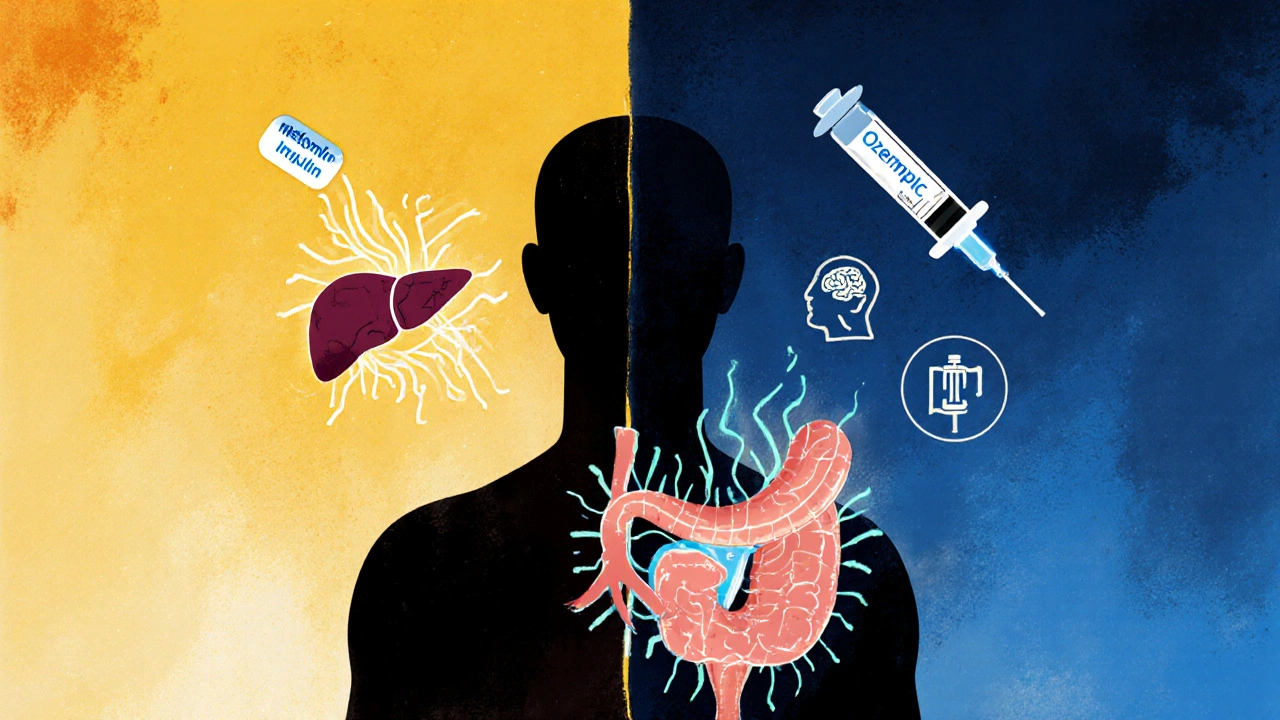
Diabetes Medication Selector
Find Your Best Fit
Answer a few questions to see which diabetes medication might be most suitable for your situation based on clinical evidence.
People often ask if metformin and Ozempic are the same because both are used for type 2 diabetes. They help lower blood sugar, but that’s where the similarity ends. Metformin has been around since the 1950s. Ozempic was approved in 2017. One is a simple, cheap tablet. The other is a weekly injection with powerful effects on weight and heart health. Confusing them can lead to wrong expectations-or worse, unsafe choices.
How Metformin Works
Metformin is the oldest and most prescribed diabetes drug in the world. It’s not a miracle drug, but it’s reliable. It works mainly by reducing how much sugar your liver releases into your bloodstream. It also helps your body use insulin better. You take it as a pill, usually once or twice a day. Most people start with 500 mg and work up to 1,500-2,000 mg daily.
It doesn’t cause low blood sugar on its own. That’s a big reason doctors start with it. It’s also cheap-often under $10 a month in the U.S. and even less in India. It’s been studied in over 100,000 people over decades. The UK Prospective Diabetes Study showed it cuts heart attack risk by 39% in overweight patients with type 2 diabetes.
Side effects? Mostly stomach issues: bloating, diarrhea, nausea. These usually fade after a few weeks. Taking it with food helps. A rare but serious risk is lactic acidosis, but that’s almost always tied to kidney failure or heavy alcohol use.
How Ozempic Works
Ozempic is the brand name for semaglutide. It’s a GLP-1 receptor agonist-a class of drugs that mimic a natural hormone your gut makes after eating. This hormone tells your pancreas to release insulin only when blood sugar is high. It also slows down digestion and tells your brain you’re full.
That’s why people lose weight on Ozempic. In clinical trials, patients lost an average of 10-15% of their body weight over a year. That’s more than most diet plans achieve. It’s given as a weekly injection under the skin. Doses start low-0.25 mg-and slowly increase to 1 mg or 2 mg depending on tolerance and need.
It’s not just for weight loss. The SUSTAIN-6 trial showed Ozempic reduces the risk of heart attack, stroke, or death from heart disease by 26% in people with type 2 diabetes and existing heart disease. It’s now approved for heart protection, not just blood sugar control.
Side effects are mostly digestive: nausea, vomiting, constipation. These are common in the first few weeks. A small number of people report gallbladder problems or pancreatitis. It’s not safe for people with a personal or family history of medullary thyroid cancer or multiple endocrine neoplasia syndrome type 2.
Key Differences at a Glance
Here’s how they stack up side by side:
| Feature | Metformin | Ozempic |
|---|---|---|
| Drug Class | Biguanide | GLP-1 Receptor Agonist |
| Form | Oral tablet | Weekly injection |
| Primary Use | Blood sugar control | Blood sugar + weight loss + heart protection |
| Typical Weight Loss | 2-5% of body weight | 10-15% of body weight |
| Cost (Monthly, India) | ₹50-₹150 | ₹8,000-₹12,000 |
| Heart Risk Reduction | Yes, moderate | Yes, strong |
| Low Blood Sugar Risk | Very low (alone) | Very low (alone) |
| Best For | First-line, budget-friendly, mild cases | Significant weight loss needed, high heart risk, poor control on metformin |

Can You Take Them Together?
Yes. In fact, doctors often combine them. Metformin handles the liver’s sugar output. Ozempic boosts insulin when needed and reduces appetite. Together, they’re more effective than either alone.
A 2023 study in The Lancet Diabetes & Endocrinology followed 1,200 people with type 2 diabetes who were not reaching their HbA1c target on metformin alone. Adding Ozempic dropped their average HbA1c from 8.2% to 6.4% in six months. Over half lost 10% or more of their body weight.
But combining them doesn’t mean you can skip diet or exercise. Ozempic makes it easier to eat less, but you still need to choose nutrient-dense foods. Metformin helps with insulin sensitivity, but physical activity boosts that effect.
Who Gets Which Drug?
Not everyone needs Ozempic. Most people with newly diagnosed type 2 diabetes start with metformin. It’s safe, affordable, and effective for mild to moderate cases.
Ozempic is usually considered when:
- Metformin alone isn’t enough to control blood sugar
- You need to lose 10+ pounds and haven’t succeeded with diet and exercise
- You have heart disease or are at high risk for it
- You can’t tolerate other injectables like insulin
In India, cost is a major factor. Many people can’t afford Ozempic long-term. Some doctors prescribe it for 3-6 months to jumpstart weight loss and then switch back to metformin with lifestyle changes.
What About Other GLP-1 Drugs Like Wegovy or Mounjaro?
Ozempic and Wegovy contain the same active ingredient-semaglutide-but Wegovy is approved for weight loss in people without diabetes. Mounjaro (tirzepatide) is newer and works on two hormones, not just one. It often leads to even more weight loss-up to 20% in trials.
But these are all newer, pricier, and harder to get. Metformin remains the backbone of diabetes treatment worldwide. It’s not glamorous, but it’s proven.

Real-Life Scenarios
Meet Priya, 52, from Bangalore. She was diagnosed with type 2 diabetes two years ago. Her HbA1c was 8.5%. She started on metformin. After six months, it dropped to 7.1%. She lost 6 kg. Still, she wanted more control and had high blood pressure. Her doctor added Ozempic. In four months, her HbA1c fell to 6.3%. She lost 14 kg. Her blood pressure improved. She now takes both and feels better than she has in a decade.
Now, Raj, 68, from Pune. He’s on metformin and has kidney disease. His doctor won’t add Ozempic because his eGFR is below 30. GLP-1 drugs aren’t recommended when kidneys are too weak. He sticks with metformin, a low-carb diet, and walking daily.
These stories show there’s no one-size-fits-all. Your body, your budget, your goals-all matter.
What Happens If You Stop Ozempic?
Many people gain weight back after stopping Ozempic. Studies show most regain about two-thirds of the lost weight within a year. That’s why doctors treat it like a long-term tool-not a quick fix.
Metformin, on the other hand, can often be stopped if you lose weight and improve your lifestyle. Some people reverse their diabetes entirely with diet, exercise, and metformin.
But stopping either drug without medical advice can cause blood sugar to spike. Never stop on your own.
Can metformin help with weight loss like Ozempic?
Metformin can help with modest weight loss-usually 2-5% of body weight-mostly by reducing appetite slightly and improving insulin sensitivity. But it’s nowhere near as powerful as Ozempic. Ozempic triggers fullness signals in the brain and slows digestion, leading to much bigger weight loss. If your goal is significant weight loss, Ozempic is far more effective.
Is Ozempic only for people with diabetes?
No. Ozempic is approved for type 2 diabetes, but its cousin, Wegovy, is approved for weight loss in people without diabetes. Both contain semaglutide. In many countries, doctors prescribe Ozempic off-label for weight loss in non-diabetic patients. However, this is often expensive and not covered by insurance unless you have diabetes.
Can I switch from metformin to Ozempic without seeing a doctor?
Absolutely not. Switching diabetes medications requires medical supervision. Stopping metformin suddenly can raise your blood sugar. Starting Ozempic too fast can cause severe nausea or pancreatitis. Your doctor will adjust doses gradually and check your kidney function, thyroid health, and other factors before starting.
Why is metformin still used if Ozempic is more effective?
Because metformin is safe, cheap, and has decades of real-world data proving it reduces complications. Ozempic is more effective for weight and heart protection, but it’s not practical for everyone. Many people manage well on metformin alone, especially if they’re young, active, and not overweight. It’s the foundation-not the competition.
Does Ozempic cause muscle loss?
Some weight loss from Ozempic can include muscle, especially if you’re not eating enough protein or not lifting weights. To preserve muscle, aim for 1.2-1.6 grams of protein per kilogram of body weight daily and include resistance training. Studies show that with proper nutrition and exercise, most weight loss on Ozempic comes from fat, not muscle.
Bottom Line
Metformin and Ozempic are not the same. One is a decades-old, affordable tablet that gently improves insulin use. The other is a powerful, injectable drug that reshapes appetite, burns fat, and protects your heart. They can work together, but they serve different purposes.
If you’re just starting out with type 2 diabetes, metformin is still the best first step. If you’ve been on it for a while and still struggle with weight or high blood sugar, Ozempic might be the next step-not a replacement, but a boost. Talk to your doctor about your goals, your budget, and your health history. Don’t let marketing or social media decide what’s right for your body.

Write a comment